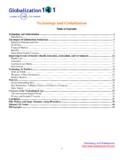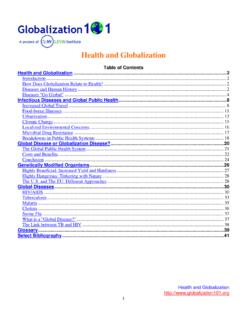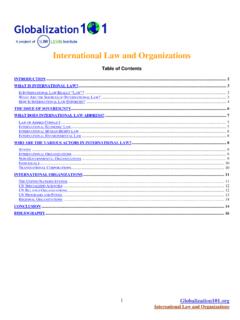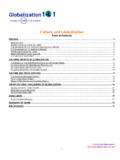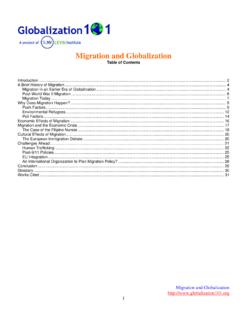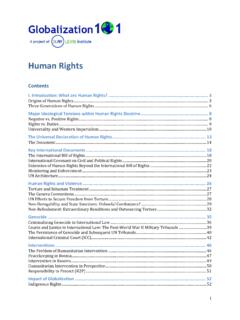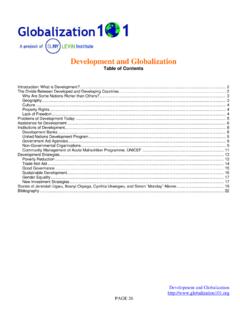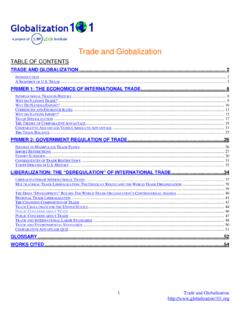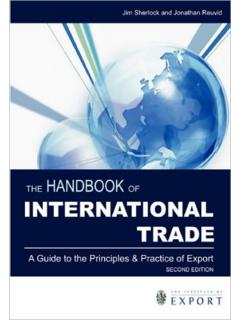Transcription of International Monetary Fund and World Bank
1 IMF and World Bank 1 International Monetary fund and World Bank Table of Contents International Financial Institutions: The IMF and the World Bank .. 2 Introduction .. 2 The Origins of the IFIs .. 2 The International Monetary fund .. 5 Governance, Organization and Purposes .. 5 How Does the IMF Achieve Its Goals? .. 6 Why Is the IMF Controversial? .. 8 The World Bank .. 11 Structure .. 11 Governance .. 11 The IBRD .. 12 International Development Association (IDA) .. 13 International Finance Corporation (IFC) .. 14 Multilateral Investment Guarantee Agency (MIGA) .. 14 International Center for Settlement of Investment Disputes (ICSID) .. 15 Why Is the World Bank Controversial? .. 16 Debt Relief .. 17 Conclusion .. 17 Glossary .. 19 Bibliography .. 23 IMF and World Bank 2 International Financial Institutions: The IMF and the World Bank Introduction Toward the end of the Second World War, in July 1944, representatives of the United States, Great Britain, France, Russia, and 40 other countries met at Bretton Woods, a resort in New Hampshire, to lay the foundation for the post-war International financial order.
2 Such a new system, they hoped, would prevent another worldwide economic cataclysm like the Great Depression that had destabilized Europe and the United States in the 1930s and had contributed to the rise of Fascism and the war. Therefore, the United Nations Monetary and Financial Conference, as the Bretton Woods conference was officially called, created the International Monetary fund (the IMF) and the World Bank to prevent economic crises and to rebuild economies shattered by the war. The Bretton Woods strategy addressed what were considered to be the two main causes of the pre-war economic downturn and obstacles to future global prosperity the lack of stable financial markets around the World that had led to the war and the destruction caused by the war itself. The IMF would be aimed at stabilizing global financial markets and national currencies by providing the resources to establish secure Monetary policy and exchange rate regimes, while the World Bank would rebuild Europe by facilitating investment in reconstruction and development.
3 Although intended to benefit the global economy and contribute to World peace, the World Bank and the IMF, collectively referred to as International financial institutions (IFIs), have become primary targets of the anti-globalization movement. In many countries, they are resented and are viewed as imposing Western-style capitalism on developing countries without regard to the social effects. The following Issue Brief is designed to help you understand the history, purpose, structure, and activities of the IFIs and to describe both benefits and concerns that surround the World Bank and the IMF. The Origins of the IFIs At the time of Bretton Woods, there was serious concern about the stability of global economic markets. The World -wide depression of the 1930s had been deepened by the instability of International currency markets and the contraction of International trade, so that stabilization of those markets and promotion of trade were considered crucial to avoid another crisis.
4 Likewise, the widespread destruction of Europe and uncertainty about its future also threatened to cause economic and political disruption. The countries allied to fight Nazi Germany and Japan believed that a similar collaborative effort was the only way to stabilize their economies and those of their soon-to-be-defeated enemies and to provide funds to rejuvenate the countries destroyed by the war. The Bretton Woods conference therefore gathered together some of the World 's most prominent minds in economic policy and some of its most powerful policy-makers to chart a new course. Representing the United States and serving as chairman of the conference was Henry Morgenthau, the Secretary of the Treasury. Morgenthau was accompanied by Harry Dexter White, the Assistant Secretary of the Treasury, who had laid the groundwork for the conference and originated the key ideas and policies to be discussed.
5 Along with them was Dean Acheson, then the Under Secretary of State, who later became Harry Truman's influential Secretary of State during the first years of the Cold War, and a number of senators and congressmen. Leading the British IMF and World Bank 3 delegation was the famed economist John Maynard Keynes. Other delegations of notables came from China, India, Russia, and France. Some leading economists from smaller nations were also quite influential at the conference, such as Louis Raminsky of Canada, Kyriakos Varvaressos of Greece, and Johan Beyen of the Netherlands. Morgenthau opened the conference by telling his fellow participants, "What we do here today will shape to a significant degree the nature of the World in which we are to live."1 The aim of the conference was to draw up plans for the IMF and World Bank (as well as a proposed International Trade Organization, which never got off the ground as a result of concerns among many countries over their economic sovereignty).
6 The conference was controversial, however, with the public, politicians, and media in many of the countries especially the United States that were wary of International control of their sovereign economic policy. Even the and British delegations, the leading countries at the conference, commented to each other that their plans had to be politically amenable to their home governments to be ultimately approved. At the same time, the conference was largely opaque to the public. The prominent American commentator Walter Lippman said, "It has been impossible for the general public to obtain any idea of what the Bretton Wood conference is about. Though it is concerned with questions which will affect men's lives deeply, the language of Monetary policy is understood by very few men in any country."2 Negotiations at the conference were, therefore, contentious.
7 Although White had drawn up plans for the proposed organizations, many details, especially regarding financial contributions to the new institutions, were still to be worked out. Countries were concerned about the balance of power within the organizations as reflected in their proportions of contributions of gold to the IMF and their concomitant ability to draw from the IMF (their "quotas"). There were extensive IMF negotiations regarding how to divide the total amount of money the IMF would have among the 44 participants. India insisted on having as high a quota as China, for example, while France insisted on having more than India and more than the three Benelux countries (Belgium, the Netherlands, and Luxembourg), who were coordinating their Monetary policy. The Russians insisted on a quota of not much less than the British and argued that they should have to contribute less gold to the fund than other countries because of their suffering in the war, but be able to draw a higher proportional quota than other countries.
8 At the same time, they refused to publish accurate economic statistics. Other disputes concerned the governance of the organizations, such as how many permanent seats the major contributors would hold and where the organizations would be located; the British unsuccessfully lobbied for the IMF to be in London. Another significant dispute revolved around whether the dollar would serve along with gold as the standard for exchange rates, which, in the end, the American delegation successfully insisted on. Meanwhile, Keynes, leading the committee that drew up plans for the World Bank, dominated the drafting process and forged the institution largely along his preferred lines and implementing his key economic idea that governments should spend their resources to stimulate their economies during slowdowns. With the diplomatic wrangling completed, the conference's Final Act was signed on July 22, 1944, although the institutions did not actually start operations until the following year.
9 In a letter read to the delegates, President Franklin Roosevelt 1 2 IMF and World Bank 4 said that they had "prepared two further foundation stones for the structure of lasting peace and security."3 How did such hope at the time result in such opposition today? The rest of this Issue Brief explains the current operations of the World Bank and the IMF and why they are so controversial. 3 IMF and World Bank 5 The International Monetary fund Governance, Organization and Purposes Governance The IMF is controlled by its 187 member-countries, each of whom appoints a representative to the IMF's Board of Governors. The Board of Governors, most of whom are the finance ministers or heads of the central bank of the members, meet once per year to discuss and possibly achieve consensus on major issues.
10 In the meantime, day-to-day operations are managed by a 24-person Executive Board. The World 's major economic and political powers the United States (the IMF's largest shareholder), Great Britain, Japan, Germany, France, China, Russia, and Saudi Arabia each have permanent seats on the executive board, while the 16 other directors are elected for two-year terms by groups of countries divided roughly by geography, , Caribbean, Africa, Southeast Asia, etc. The executive board, in turn, is run by the managing director, who is elected for renewable five-year terms. The IMF also has an International Monetary and Financial Committee of 24 representatives of the member-countries that meets twice yearly to provide advice on the International Monetary and financial system to the IMF's staff. In all of its operations, voting power is weighted based on the size of the economy and therefore the quota allocation of each country.
